The global industrial wired routers market is projected to grow from USD 102.5 million in 2025 to approximately USD 242.6 million by 2035, recording an absolute increase of USD 140.1 million over the forecast period. This translates into a total growth of 136.8%, with the market forecast to expand at a compound annual growth rate (CAGR) of 9.0% between 2025 and 2035. The market size is expected to grow by 2.4X during the same period, supported by accelerating demand for reliable network connectivity in industrial automation systems, increasing deployment of Industry 4.0 technologies across manufacturing facilities, and expanding adoption of edge computing architectures in production environments worldwide.
The consistent market expansion reflects the critical role of wired connectivity solutions in supporting industrial digitalization initiatives and operational technology convergence. Major industrial equipment manufacturers globally are incorporating advanced wired router systems to enhance network reliability and reduce latency in mission-critical applications, while breakthrough developments in industrial networking protocols and fiber optic integration technologies are creating substantial demand for specialized routing platforms that deliver superior data throughput and operational stability under harsh industrial conditions.

Manufacturing capabilities are advancing as leading network infrastructure providers invest in ruggedized hardware development facilities and proprietary network management software to meet growing market demand for enhanced connectivity performance and reduced maintenance requirements. The technology landscape continues evolving with innovations in network security architectures, protocol optimization, and real-time data processing systems that enhance network efficiency while reducing hardware complexity. Industrial automation suppliers and networking specialists are collaborating extensively to develop next-generation wired router products that address specific connectivity requirements across manufacturing plants, energy facilities, and transportation infrastructure systems.
Quality standards are becoming increasingly rigorous as applications demand higher reliability specifications and greater operational continuity under extreme environmental conditions including temperature variations, electromagnetic interference, and vibration exposure. Industry certification programs and validation protocols ensure consistent product performance while supporting market confidence in industrial networking technology adoption across critical infrastructure systems and regulated industrial environments. Regulatory compliance requirements for industrial and safety applications are driving investments in comprehensive quality assurance systems and testing protocols throughout the manufacturing supply chain.
International collaboration is accelerating market development as major infrastructure projects require coordinated efforts between multiple network equipment providers and system integrators. Global industrial companies are establishing standardized specifications for network router performance that influence worldwide manufacturing standards and create opportunities for specialized networking equipment suppliers. Industrial engineering firms are forming strategic partnerships with router technology developers to create application-specific solutions tailored to emerging industrial architectures and automation system requirements.
Investment patterns are shifting toward integrated solution development as major industrial operators seek comprehensive network routing systems that combine high-speed data transmission capabilities with advanced network management and predictive maintenance features. Industrial companies are forming joint ventures with technology providers to develop customized networking platforms, while equipment manufacturers are acquiring stakes in specialized router technology companies to ensure access to cutting-edge connectivity technologies for their installation and development programs. This trend toward strategic partnerships and technology integration is reshaping competitive dynamics across the industrial networking value chain.
Market maturation is evident in the emergence of specialized application segments that demand unique router characteristics and performance specifications. Energy sector applications require extremely stable network performance and fault tolerance under critical infrastructure requirements, while manufacturing systems need router solutions that maintain accuracy and reliability when handling complex automation protocols and real-time control system integration requirements. These specialized requirements are driving innovation in routing technologies, security architectures, and integration methodologies that extend beyond traditional industrial networking and data communication applications.
| Metric | Value |
|---|---|
| Market Value (2025) | USD 102.5 million |
| Market Forecast Value (2035) | USD 242.6 million |
| Forecast CAGR (2025-2035) | 9.0% |
| INDUSTRIAL AUTOMATION ADVANCEMENT | EDGE COMPUTING INTEGRATION | NETWORK SECURITY ENHANCEMENT |
|---|---|---|
| Industry 4.0 Implementation: Industrial automation systems requiring sophisticated wired router networks for machine-to-machine communication, production line coordination, and quality control applications with enhanced data processing capabilities and real-time monitoring protocols across manufacturing environments. | Edge Data Processing: Edge computing architectures implementing integrated router systems for local data processing, reduced latency requirements, and bandwidth optimization with superior connectivity performance and distributed computing capabilities. | Cybersecurity Requirements: Industrial cybersecurity standards requiring enhanced network router technology for threat protection, access control, and secure data transmission applications with certified security protocols and comprehensive monitoring capabilities. |
| Manufacturing Digitalization: Digital transformation initiatives across production facilities requiring specialized router infrastructure for sensor networks, automated systems, and process optimization applications with superior accuracy under dynamic industrial conditions and operational variations. | Real-Time Analytics: Industrial analytics platforms requiring router networks for data collection, processing coordination, and system integration requiring robust hardware platforms and comprehensive software integration capabilities. | Compliance Standards: Industrial safety and security regulations requiring router systems for network monitoring, access management, and audit trail applications with standardized communication protocols and data exchange capabilities. |
| Process Optimization: Production efficiency enhancement requiring specialized router technology for workflow coordination, resource management, and performance monitoring systems implementing router networks with certified performance under regulatory testing protocols. | Distributed Control Systems: Advanced process control implementations requiring router infrastructure for distributed operations, remote monitoring, and system coordination with flexible installation options and compatibility across multiple industrial platforms. | Data Protection: Industrial data protection requirements implementing router technology for encrypted communications, secure tunneling, and network segmentation with comprehensive security features and performance monitoring capabilities. |
| Category | Segments / Values |
|---|---|
| By Type | Cable Connection; Mobile Network Connection; Railway Connection; Fiber Optic Connection; Others |
| By Application | Energy Sector; Oil and Gas; Manufacturing and Processing Sector; Road Infrastructure; Railway Sector; Water Management; Mining Operations; Others |
| By End-User | Industrial Manufacturers; System Integrators; Network Service Providers; Government Agencies; Others |
| By Technology | Ethernet Routers; Fieldbus Routers; Wireless Gateway Integration; Protocol Converters; Others |
| By Distribution Channel | Direct Sales; System Integrators; Industrial Distributors; Online Platforms |
| By Region | North America; Europe; Asia Pacific; Latin America; Middle East & Africa |
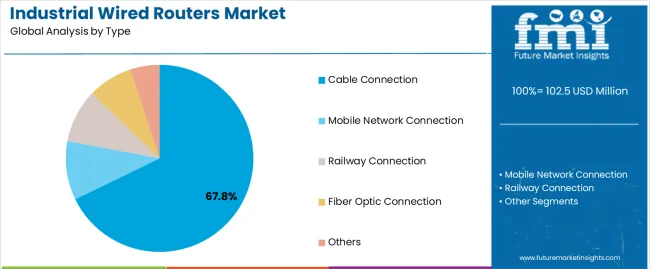
| Segment | 2025-2035 Outlook |
|---|---|
| Cable Connection |
|
| Mobile Network Connection |
|
| Railway Connection |
|
| Others |
|

| Segment | 2025-2035 Outlook |
|---|---|
| Energy Sector |
|
| Oil and Gas |
|
| Manufacturing and Processing Sector |
|
| Others |
|
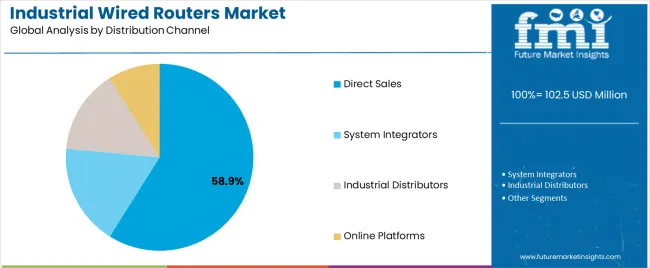
| Distribution Channel | Status & Outlook (2025-2035) |
|---|---|
| Direct Sales |
|
| System Integrators |
|
| Industrial Distributors |
|
| Technology Partners |
|
| DRIVERS | RESTRAINTS | KEY TRENDS |
|---|---|---|
| Industrial IoT Expansion across manufacturing and process industries creating substantial demand for specialized wired router devices supporting sensor networks, automated systems, and real-time data collection systems requiring enhanced connectivity and network management capabilities. | High Infrastructure Costs and complex installation requirements limit accessibility across smaller industrial facilities and budget-conscious operators with limited networking technology upgrade budgets. | Protocol Standardization: Advanced router systems incorporating multiple industrial communication protocols, unified network management platforms, and interoperability features for enhanced system integration and operational efficiency optimization. |
| Network Reliability Requirements: Industrial process control and safety system advancement driving adoption of integrated router technology for mission-critical communications, emergency response coordination, and operational continuity applications. | Technical Integration Complexity: Installation requirements, system compatibility studies, and specialized maintenance procedures affect deployment timelines and operational capabilities for industrial facilities lacking dedicated networking expertise. | Edge Computing Integration: Innovations in distributed processing capabilities, local data analytics, and real-time decision-making delivering enhanced network performance, reduced latency, and improved operational responsiveness for industrial applications. |
| Cybersecurity Enhancement: Industrial facility security and data protection driving adoption of router systems for network segmentation, access control, and secure communications with superior integration performance and operational monitoring capabilities. | Legacy System Compatibility: Existing industrial infrastructure and established communication protocols create integration challenges for router system deployment affecting market adoption and technology development timelines. | Remote Management Capabilities: Expanding integration with cloud platforms, centralized monitoring systems, and predictive maintenance technologies creating comprehensive network management platforms that support diverse operational requirements and accessibility needs. |
| Regulatory Compliance: Industrial safety enhancement and operational standards requiring advanced networking technology implementing router systems for monitoring, reporting, and communication applications across regulated industrial environments. | Market Fragmentation: Diverse industrial applications, protocol requirements, and technology standards create complexity for suppliers developing universal router solutions across multiple industrial sectors and equipment types. | Artificial Intelligence Integration: Integration with machine learning algorithms, predictive analytics capabilities, and automated network optimization features enabling intelligent routing decisions, performance monitoring, and system maintenance for enhanced operational efficiency. |

| Country | CAGR (2025-2035) |
|---|---|
| China | 12.1% |
| India | 11.2% |
| Germany | 10.4% |
| Brazil | 9.5% |
| United States | 8.6% |
| United Kingdom | 7.7% |
| Japan | 6.8% |

Revenue from industrial wired routers in China is projected to exhibit exceptional growth with a market value of USD 79.4 million by 2035, driven by massive industrial automation programs and comprehensive manufacturing digitalization initiatives creating substantial opportunities for router technology suppliers across production facility networking, process control systems, and smart factory development sectors. The country's ambitious Industry 4.0 development programs including national manufacturing transformation initiatives and intelligent production infrastructure expansion are creating unprecedented demand for specialized industrial networking systems. Major manufacturing companies and technology providers including Huawei, ZTE, and industrial automation specialists are establishing comprehensive router development programs to support large-scale industrial production and advanced manufacturing technology applications.
Demand for industrial wired routers in India is anticipated to expand to reach USD 51.8 million by 2035, supported by extensive industrial infrastructure development programs and comprehensive manufacturing facility modernization initiatives creating demand for router solutions across diverse production automation and process control application segments. The country's growing industrial manufacturing capabilities and expanding technology infrastructure are driving demand for networking components that provide exceptional reliability while supporting advanced industrial system requirements. Manufacturing companies and industrial facilities are investing in router technology development to support growing production demand and industrial automation advancement requirements.
Demand for industrial wired routers in Germany is projected to reach USD 38.1 million by 2035, supported by the country's leadership in industrial automation technology and advanced manufacturing systems requiring sophisticated router solutions for precision production and industrial technology applications. German industrial operators are implementing cutting-edge networking platforms that support advanced coordination capabilities, operational precision, and comprehensive performance monitoring protocols. The market is characterized by focus on engineering excellence, technology innovation, and compliance with stringent industrial safety and performance standards.
Revenue from industrial wired routers in Brazil is growing to reach USD 29.2 million by 2035, driven by industrial infrastructure development programs and increasing manufacturing capabilities creating opportunities for router suppliers serving both industrial operators and specialized technology contractors. The country's expanding industrial sector and growing manufacturing technology infrastructure are creating demand for networking components that support diverse industrial requirements while maintaining performance standards. Industrial companies and manufacturing facilities are developing technology strategies to support operational efficiency and system reliability advancement.
Demand for industrial wired routers in United States is projected to reach USD 22.6 million by 2035, expanding at a CAGR of 8.6%, driven by advanced industrial technology innovation and specialized high-performance applications supporting precision manufacturing and comprehensive industrial automation applications. The country's established industrial technology tradition including major equipment manufacturers and automation facilities are creating demand for high-performance router components that support operational advancement and safety standards. Manufacturers and industrial system suppliers are maintaining comprehensive development capabilities to support diverse industrial and technology requirements.
Revenue from industrial wired routers in United Kingdom is growing to reach USD 17.4 million by 2035, supported by industrial technology heritage and established manufacturing communities driving demand for premium router solutions across traditional industrial systems and specialized manufacturing technology applications. The country's industrial engineering heritage including major equipment manufacturers and established industrial system capabilities create demand for networking components that support both legacy system advancement and modern industrial applications.
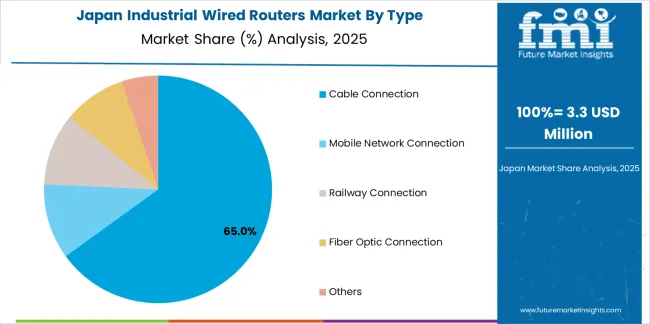
Demand for industrial wired routers in Japan is projected to reach USD 13.5 million by 2035, driven by precision industrial technology tradition and established manufacturing leadership supporting both domestic industrial system markets and export-oriented component production. Japanese companies maintain sophisticated router development capabilities, with established manufacturers continuing to lead in networking technology and industrial equipment standards.
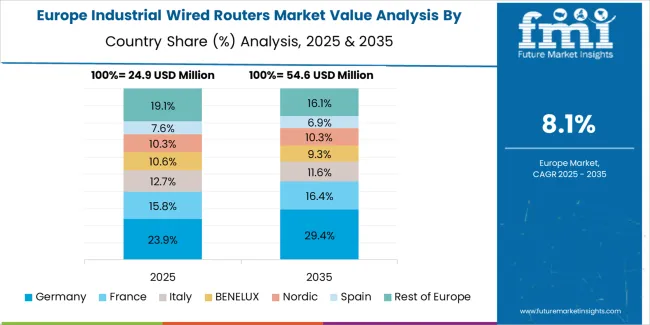
European industrial wired routers operations are increasingly concentrated between German engineering excellence and specialized manufacturing across multiple countries. German facilities dominate high-performance router production for precision industrial and manufacturing technology applications, leveraging cutting-edge networking technologies and strict quality protocols that command price premiums in global markets. British industrial technology operators maintain leadership in system innovation and router development methodologies, with organizations like major industrial equipment manufacturers and university research centers driving technical specifications that suppliers must meet to access major industrial contracts.
Eastern European operations in Czech Republic and Poland are capturing specialized production contracts through precision manufacturing expertise and EU compliance standards, particularly in component fabrication and assembly technologies for industrial applications. These facilities increasingly serve as development partners for Western European industrial programs while building their own manufacturing technology expertise.
The regulatory environment presents both opportunities and constraints. European industrial safety framework requirements create quality standards that favor established European manufacturers and industrial system operators while ensuring consistent performance specifications for critical infrastructure and safety applications. Brexit has created complexity for UK industrial collaboration with EU programs, driving opportunities for direct relationships between British operators and international router suppliers.
Technology collaboration accelerates as industrial manufacturers seek networking advancement to support major automation milestones and Industry 4.0 development timelines. Vertical integration increases, with major industrial system operators acquiring specialized manufacturing capabilities to secure component supplies and quality control for critical industrial programs. Smaller industrial contractors face pressure to specialize in niche applications or risk displacement by larger, more comprehensive operations serving mainstream industrial and technology requirements.
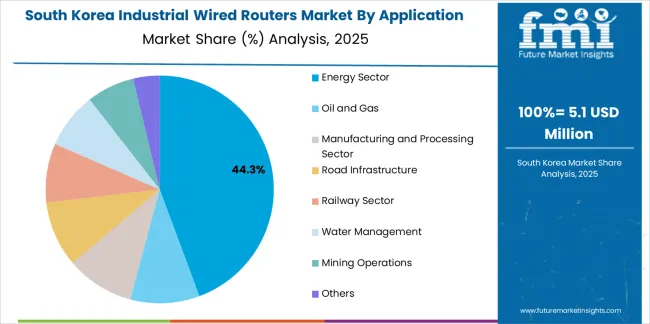
South Korean industrial wired routers operations reflect the country's advanced manufacturing technology capabilities and export-oriented industrial development model. Major industrial system operators including Samsung Electronics and technology companies drive component procurement strategies for their manufacturing facilities, establishing direct relationships with specialized router suppliers to secure consistent quality and performance for their industrial development programs and advanced manufacturing technology systems targeting both domestic infrastructure and international collaboration projects.
The Korean market demonstrates particular strength in integrating router technologies into smart factory platforms and advanced industrial system configurations, with engineering teams developing solutions that bridge traditional manufacturing networking applications and next-generation industrial systems. This integration approach creates demand for specific performance specifications that differ from conventional applications, requiring suppliers to adapt router capabilities and system coordination characteristics.
Regulatory frameworks emphasize industrial safety and system reliability, with Korean industrial standards often exceeding international requirements for networking systems. This creates barriers for standard component suppliers but benefits established manufacturers who can demonstrate industrial-grade performance capabilities. The regulatory environment particularly favors suppliers with Korean industrial system qualification and comprehensive testing documentation systems.
Supply chain excellence remains critical given Korea's manufacturing focus and international collaboration dynamics. Industrial system operators increasingly pursue development partnerships with suppliers in Japan, Germany, and specialized manufacturers to ensure access to cutting-edge router technologies while managing infrastructure risks. Investment in industrial infrastructure supports performance advancement during extended manufacturing development cycles.
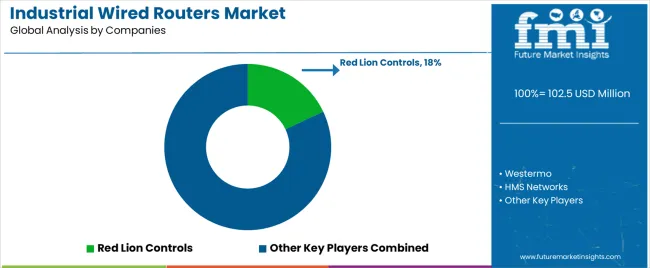
Profit pools are consolidating upstream in advanced router technology manufacturing and downstream in application-specific solutions for industrial automation, energy sector applications, and manufacturing markets where network performance, integration complexity, and exceptional reliability command substantial premiums. Value is migrating from basic router production to specification-driven, industrial-grade networking systems where protocol expertise, ruggedized hardware manufacturing, and reliable integration capabilities create competitive advantages. Several archetypes define market leadership: established American technology companies defending share through advanced networking platform development and comprehensive industrial integration support; German industrial suppliers leveraging manufacturing excellence and automation system capabilities; Scandinavian networking leaders with industrial expertise and reliability manufacturing heritage; and emerging technology manufacturers pursuing cost-effective production while developing advanced router capabilities. Switching costs - system integration, protocol compatibility validation, industrial certification - provide stability for established suppliers, while technological advancement requirements and specialized application growth create opportunities for innovative networking manufacturers. Consolidation continues as companies seek manufacturing scale; direct industrial partnerships grow for specialized applications while traditional industrial distribution remains relationship-driven. Focus areas: secure energy sector and manufacturing market positions with application-specific performance specifications and technical collaboration; develop router technology and advanced manufacturing capabilities; explore specialized applications including smart grid and industrial IoT infrastructure requirements.
| Stakeholder Type | Primary Advantage | Repeatable Plays |
|---|---|---|
| American Technology Leaders | Advanced networking platform expertise; proven industrial integration; established customer relationships | Precision manufacturing; technical innovation; industrial certification support |
| German Industrial Suppliers | Manufacturing excellence; comprehensive automation development programs; established customer partnerships | Engineering collaboration focus; integrated solutions; technical consultation |
| Scandinavian Networking Leaders | Industrial system expertise; reliability technology leadership; trusted by major industrial programs | Customer partnerships; application-specific specifications; industrial infrastructure collaboration |
| Emerging Technology Producers | Manufacturing efficiency; competitive pricing; rapid technology development | Production scaling; technology advancement; market entry strategies |
| Industrial Distributors | Technical distribution networks; industrial service relationships | Industrial expertise; inventory management; technical support services |
| Item | Value |
|---|---|
| Quantitative Units | USD 102.5 million |
| Type Segments | Cable Connection; Mobile Network Connection; Railway Connection; Fiber Optic Connection; Others |
| Applications | Energy Sector; Oil and Gas; Manufacturing and Processing Sector; Road Infrastructure; Railway Sector; Water Management; Mining Operations; Others |
| End-Users | Industrial Manufacturers; System Integrators; Network Service Providers; Government Agencies; Others |
| Technology Segments | Ethernet Routers; Fieldbus Routers; Wireless Gateway Integration; Protocol Converters; Others |
| Distribution Channels | Direct Sales; System Integrators; Industrial Distributors; Online Platforms |
| Regions Covered | North America; Latin America; Europe; Asia Pacific; Middle East & Africa |
| Key Countries | China; India; Germany; Brazil; United States; United Kingdom; Japan (+35 additional countries) |
| Key Companies Profiled | Red Lion Controls; Westermo; HMS Networks; Phoenix Contact; KEB Automation; Wieland Electric GmbH; Xiamen Baima Technology Co Ltd; MB connect line GmbH; Mulogic BV; Siemens AG; Cisco Systems; Advantech Co Ltd; Moxa Inc; Hirschmann Automation and Control GmbH; Pepperl+Fuchs SE; Belden Inc; WAGO Corporation; Schneider Electric SE |
| Additional Attributes | Dollar sales by type and application; Regional demand trends (NA, EU, APAC); Competitive landscape; Direct vs. distributor adoption patterns; Industrial manufacturing and technology integration; Advanced networking innovations driving connectivity enhancement, integration reliability, and industrial safety excellence |
The global industrial wired routers market is estimated to be valued at USD 102.5 million in 2025.
The market size for the industrial wired routers market is projected to reach USD 242.7 million by 2035.
The industrial wired routers market is expected to grow at a 9.0% CAGR between 2025 and 2035.
The key product types in industrial wired routers market are cable connection, mobile network connection, railway connection, fiber optic connection and others.
In terms of application, energy sector segment to command 42.3% share in the industrial wired routers market in 2025.






Full Research Suite comprises of:
Market outlook & trends analysis
Interviews & case studies
Strategic recommendations
Vendor profiles & capabilities analysis
5-year forecasts
8 regions and 60+ country-level data splits
Market segment data splits
12 months of continuous data updates
DELIVERED AS:
PDF EXCEL ONLINE
Industrial Robot Controller Market Size and Share Forecast Outlook 2025 to 2035
Industrial Evaporative Condensers Market Size and Share Forecast Outlook 2025 to 2035
Industrial Energy Management System Market Size and Share Forecast Outlook 2025 to 2035
Industrial Insulation Market Size and Share Forecast Outlook 2025 to 2035
Industrial Safety Gloves Market Size and Share Forecast Outlook 2025 to 2035
Industrial Cleaner Market Size and Share Forecast Outlook 2025 to 2035
Industrial Dust Treatment System Market Size and Share Forecast Outlook 2025 to 2035
Industrial Vertical Washing Tower Market Size and Share Forecast Outlook 2025 to 2035
Industrial Pepper Market Size and Share Forecast Outlook 2025 to 2035
Industrial Electronics Packaging Market Forecast and Outlook 2025 to 2035
Industrial Absorbent Market Forecast and Outlook 2025 to 2035
Industrial Furnace Industry Analysis in Europe Forecast and Outlook 2025 to 2035
Industrial Denox System Market Size and Share Forecast Outlook 2025 to 2035
Industrial Electronic Pressure Switch Market Size and Share Forecast Outlook 2025 to 2035
Industrial WiFi Module Market Size and Share Forecast Outlook 2025 to 2035
Industrial Security System Market Forecast Outlook 2025 to 2035
Industrial Film Market Forecast Outlook 2025 to 2035
Industrial Floor Mat Market Forecast Outlook 2025 to 2035
Industrial Process Water Coolers Market Forecast and Outlook 2025 to 2035
Industrial Grade Ammonium Hydrogen Fluoride Market Forecast and Outlook 2025 to 2035

Thank you!
You will receive an email from our Business Development Manager. Please be sure to check your SPAM/JUNK folder too.
Chat With
MaRIA